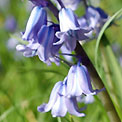Spanish bluebell, Hyacinthoides hispanica

Other common names
Escila, forest hyacinth, hispanic hyacinthoides, Spanish squill, wood hyacinth, xi ban ya lan zhong hua.
Other scientific names
Spanish bluebells, have at various times, had different scientific names including Endymion campanulatus, Endymion hispanicus, Endymion patulus, Scilla campanulatus and Scilla hispanica.
Description

Spanish bluebells are perennial herbs growing from a bulb.
The basal leaves are few in number (4-8) per bulb. Leaves may be between 20-50cm long and 10-35mm wide and are erect at first but become floppy and spread across the ground later in the season. The leaf shape is usually linear or oblong in outline and often has a blunt tip. The leaves are smooth, shiny and slightly succulent.
The flower spike is usually 20-50cm high, with the flowers arranged in a raceme that is stiff and upright. Each raceme normally has between 4 and 20 flowers that are usually attached to the main stem on all sides.
The flowers usually point outwards. Each flower has two linear-lanceolate bracts, one usually longer than the other, at the base of the flower stalk. The flower stalk is normally 10-20mm long. The flowers are usually pale to mid-blue (sometimes white or pink). Each flower is made up of six petals that are fused together at the base to form a wide-open bell. Flowers are normally 15-25mm in diameter and each petal is usually 15-22mm long. The petals are widely spreading and are usually not rolled back.
The three inner stamens are almost as along as the three outer stamens. The filaments of the outer stamens are usually attached to the petal for less than therre quarters of their length. The anthers are usually pale to mid-blue. Flowers are usually unscented, even on warm days.

Origin and Distribution
The true Spanish Bluebell is a native of Spain and Portugal. There are many other plants that we also think of as Spanish but these are unlike the wild Spanish bluebells. They have an extra set of chromosomes, pieces of DNA material, and they are bigger, broader, leaved plants. We are currently investigating the origin of this horticultural form. Records of narrow-leaved plants with very blue pollen which may be the true wild Spanish bluebell would be very welcome.
Spanish bluebells are mainly found in the vicinity of villages, towns and cities. They are frequent in churchyards, cemeteries, parks and gardens, they also occur as either escapes or "throw-outs" alongside road-verges, wastelands, hedgerows and woodland borders.
The distribution of this bluebell is not accurately known but it appears to be infrequent in upland areas, particularly in Scotland. Due to past confusion, many earlier records for this plant may be the Hybrid bluebell.
